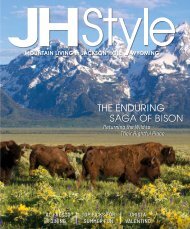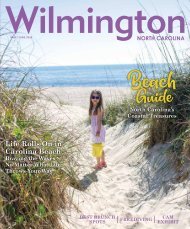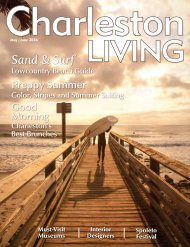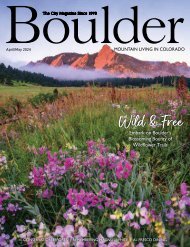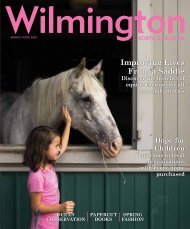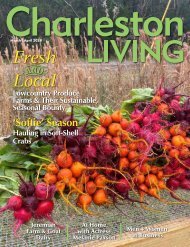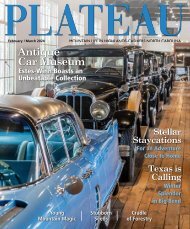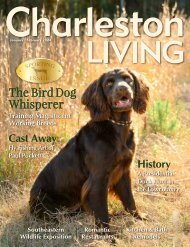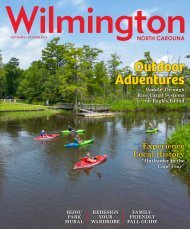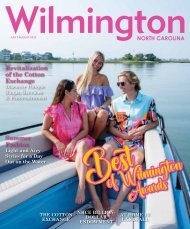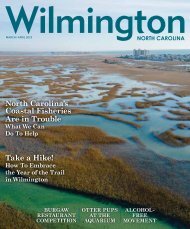Plateau Magazine June-July 2023
This issue we feature women entrepreneurs with locally run businesses and cowgirls who are protecting local animals. We also highlight protecting the land and fields that are important for bees and butterflies pollination. And for the foodies, check out our feature on the Highlands Tavern. Get outdoors with this issue, with our interview on legendary hiker Jennifer Pharr Davis.
This issue we feature women entrepreneurs with locally run businesses and cowgirls who are protecting local animals. We also highlight protecting the land and fields that are important for bees and butterflies pollination. And for the foodies, check out our feature on the Highlands Tavern. Get outdoors with this issue, with our interview on legendary hiker Jennifer Pharr Davis.
You also want an ePaper? Increase the reach of your titles
YUMPU automatically turns print PDFs into web optimized ePapers that Google loves.
species, preserve watersheds and restore<br />
connectivity between ecosystems.<br />
This site will be HCLT’s first public<br />
hiking trail in Cashiers and is a potential<br />
site for a pocket meadow, a sustainable<br />
approach to gardening for wildlife. Pocket<br />
meadows are small, native plantings<br />
inspired by the natural landscape that<br />
offer the same ecological benefits of wild<br />
meadows but on a smaller, more manageable<br />
scale. This type of gardening supports<br />
insects and recreates an ecological web as<br />
it rebuilds a sustainable habitat. In addition,<br />
headwater seeps on the property provide<br />
wetland habitat, which is abundant in<br />
animal and plant life.<br />
The property will also serve as a buffer<br />
to developed spaces, critical at this time<br />
of proposed development in Cashiers, and<br />
preserve green space, which positively impacts<br />
all communities. This site could well<br />
become our own mini-Central Park, preserving<br />
what we so love about living here.<br />
Satulah Mountain<br />
As the first purchase of HIA, which would<br />
eventually become HCLT, one could argue<br />
that it all started here. This land had been<br />
slated to become a hilltop hotel, but HIA<br />
knew it could serve a better, long-term<br />
purpose, and it raised $500 to purchase<br />
the 56 acres outright. This purchase protected<br />
the right of people “to behold the<br />
beauties of the sunset, starlit heavens, and<br />
the glories of the sunrise.”<br />
At 4543 feet, Satulah Mountain is one of<br />
the tallest peaks of the Blue Ridge Escarpment<br />
and is often referred to as an “island<br />
in the sky.” It is also home to a number of<br />
rare and unusual plant species including<br />
granite dome goldenrod, Hartweg’s locust<br />
and dwarf juniper. The trees at the ridgetop<br />
forest are likely close to 300 years old<br />
even though conditions have dwarfed them<br />
to deceivingly small heights and girths. In<br />
addition, the land is dominated by ericaceous<br />
shrub species including rhododendron,<br />
azalea, huckleberry and mountain<br />
laurel.<br />
The trail on Satulah Mountain is over<br />
100 years old, and visitors can explore the<br />
old stone house used by the earliest hikers.<br />
In fact, there is much history here, for this<br />
is where Highlands was born. The rock at<br />
the summit, where the Forest Service Fire<br />
Tower once stood, is the very spot where<br />
Samuel Kelsey, founder of Highlands, was<br />
inspired to found the town.<br />
As a registered North Carolina National<br />
94 | The<strong>Plateau</strong>Mag.com<br />
Pink lady slippers<br />
(Cypripedium acaule)<br />
in bloom on hiking<br />
trail in Edward Baker<br />
Preserve.<br />
Stag's-horn clubmoss<br />
(Lycopodium clavatum)<br />
found in abundance<br />
at Edward Baker<br />
Preserve.<br />
Heritage site, the property holds historical<br />
and future cultural significance. The<br />
North Carolina National Heritage Program<br />
is a program of the Division of Land<br />
and Water Stewardship within the North<br />
Carolina Department of Natural and Cultural<br />
Resources. By gathering and sharing<br />
information about rare species and natural<br />
Boys & Girls Club teens volunteering<br />
at Edward Baker Preserve to help<br />
build hiking trails.<br />
communities, this program ensures public<br />
access to information needed to weigh the<br />
ecological significance of natural areas and<br />
to evaluate potential ecological impacts of<br />
conservation and development projects. In<br />
other words, it helps us grow in a way that<br />
is sustainable and preserves the spirit and<br />
integrity of these mountains.<br />
Dixon Woods<br />
Dixon Woods is one of the flattest hikes in<br />
Highlands, allowing those who cannot or<br />
do not wish to tackle the rougher terrain<br />
to enjoy our beautiful landscape. Located<br />
at the headwaters of the Cullasaja River,<br />
the site is lush with vegetation and animal<br />
life and has an on-site pond that serves as<br />
a breeding site for salamanders, a species<br />
critical to the ecosystem.<br />
In addition, HCLT is developing a<br />
wildlife pocket meadow that will provide<br />
pollinator habitat, vegetation for wildlife<br />
and respite for two-legged visitors. Once<br />
complete, the pocket meadow will provide<br />
a beautiful clearing next to a stream. With<br />
picnic tables and abundant wildflowers,<br />
this will no doubt become a favorite site for<br />
locals and visitors alike.<br />
These are only four of the many sites<br />
over which HCLT acts as steward, but they<br />
are good examples of why HCLT’s work is<br />
critical here on the plateau. We need to protect<br />
our wild places. These places support<br />
the web of life by protecting flora and fauna<br />
of all make, including our precious pollinators.<br />
The connected parks and green spaces<br />
offer innumerable health benefits by promoting<br />
physical activity and connecting us<br />
with nature. And let’s not forget the birds.<br />
The National Audubon Society and Bird<br />
Life International have designated the plateau<br />
as one of the most important bird areas<br />
of the world. Birds of high conservation<br />
priority, including the Black-throated blue<br />
warbler, Canada warbler, Golden-crowned<br />
Kinglet hooded warbler, Rose-breasted<br />
Grosbeak and the Red-breasted nuthatch,<br />
thrive in these mountains.<br />
If the mountains speak to you, speak<br />
back by supporting HCLT. Whether it is<br />
time, land or resources, we can all do our<br />
part. Think of this as a gift to your children<br />
and grandchildren—and their children and<br />
grandchildren. It is a promise to future<br />
generations that the beauty and integrity of<br />
the plateau will endure. It is a gift that will<br />
outlast us all. It is a legacy of love. P



